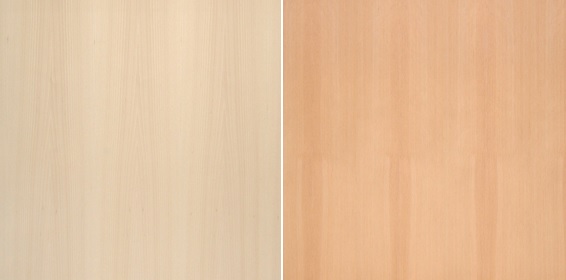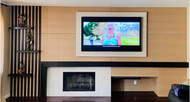Beech Veneer Styles and Cuts: What You Need to Know
Jan 25th 2023
Beech is a beautiful, stately wood, with a light tone that typically ranges between light, warm tan, and golden yellow to something that might be described as nearly light pink. Widely referred to as “The Mother of the Forest,” beech wood is revered in woodworking and design for its beautiful luster, even grain, workability, strength, and durability.
Beechwood - specifically beech veneer is considered an exotic wood veneer. It is used for wood paneling, partitioning, and accenting and is particularly well suited to interior design schemes such as Scandinavian and Industrial styles because it is demure, stately, and handsome.
There are a few different broad classes of beech wood. We offer American and European beech wood veneer sheets, as well as Yellow beech, in several different cuts and styles. It is available in 4’x8’, 4’x10’, and 4’x12’ sheet veneer. The sheets are rolled into a box and are shipped directly to the contractor or the Do-It-Yourselfer. Here’s what you need to know about the different cuts and styles.
Flat Cut Veneer
Flat cut is also known as plain-sliced or plain-sawn, and refers to the method of cutting thin veneer sheets by mounting either a half, third, or quarter of a log on a saw table with the heart facing away from the blade; the cut is made parallel to the grain.
The result of flat-sawing veneer panels produces visibly different grain patterns. Flat-cut veneer sheets often exhibit open grain patterns, and a specific trait known as “cathedrals,” due to their resemblance to church spires. Flat-cut wood veneer sheets often exhibit arched grain patterns as well; you can see these in the image at the top of this blog, specifically on the hood over the stove in the picture.
This style of cut is appealing to homeowners, DIY’ers and decorators due to the unique patterns and natural movement of the wood’s grain.
Quarter Cut Veneer
Quarter-cut veneer sheets are also run through a mill, but first, the log is first quartered. The log is sawn in such a manner that the growth rings are perpendicular to the blade. Also, quartering the log before milling changes the angle at which the grain approaches the blade.
The effect is that quarter-sawn or quarter-cut wood veneer sheets exhibit a fairly straight grain pattern. Quarter-sawn veneer also often produces “flakes,” resulting from the medullary rays of the wood that show through the grain when it is cut in this manner.
Quarter-sawn veneer sheets have the “neatest” or most “symmetrical” appearance, for lack of a better term, making them perfect for a wide range of interior design schemes in which the muted, pleasant golden tones of beech would be appropriate.
Knotty/Random Plank
While both plain and quarter-cut beech veneer sheets offer relative symmetry and a “polished” look, knotty and random plank veneer sheets exhibit natural aberrations in color and grain orientation that some designers find appealing.
Knotty and random plank veneer sheets often have grain anomalies, knots, and pockets that create a pleasing sense of aesthetic movement and inconsistency that, almost unexpectedly, creates a unique sort of harmony.
Designers and woodworkers also appreciate knotty wood for its ability to work well in situations in which there is an interplay between both dark and light color schemes. It also is appreciated for its rustic impression. Knotty wood veneer sheets, not just beech, work well in cabins, lodges, farmhouses, and other design schemes that attempt to mimic these bucolic settings.
Steamed vs. Unsteamed Veneer?
You may also notice that some of the veneer sheets on our website are categorized as steamed or unsteamed.
Steaming, also known as “cooking” wood, refers to the process of treating wood in hot water before creating veneer sheets. It serves two different purposes. One is that it makes the wood more pliable, which allows it to produce a more even, smooth cut. Some believe that steamed wood produces higher-quality wood veneer with a superior finish.
The other effect produced by steaming wood is aesthetic. Steamed veneer tends to have a slightly warmer color. Some describe this as “pink,” but it is certainly darker and warmer. You can see this difference in the juxtaposition of steamed and unsteamed beech veneer sheets below, with the unsteamed sheet on the left and the steamed version on the right.

Why Wood Veneer Instead of Solid Hardwood?
There are a variety of good reasons to choose veneer over solid hardwood.
One is that, aesthetically, it is effectively impossible to tell the difference between furniture, decorations, and other home goods that are produced using veneer sheets instead of solid hardwood. Wood veneer has the same exact appearance as solid hardwood, and like it, can often accept a variety of stains and finishes.
Veneer is also more affordable than solid hardwood, making it much more practical for many DIY’ers. In addition, one tree can be used to produce much more wood veneer than solid furniture, making veneer more economical and more eco-friendly.
Finally, solid hardwood is prone to warping, splitting, cracking, and other issues, whereas veneer is not. So long as you take care of the veneer, protecting it from moisture, sunlight, and excessive swings in temperature, it requires much less maintenance than solid wood.
Get in Touch with Us to Learn More About Beech Veneer!
If you’re interested in veneering a project that makes use of the beautiful, warm hues and attractive grain of beech veneer, but still have questions about how much veneer costs before proceeding, feel free to get in touch with us at 800-426-6018. We would be happy to help!
